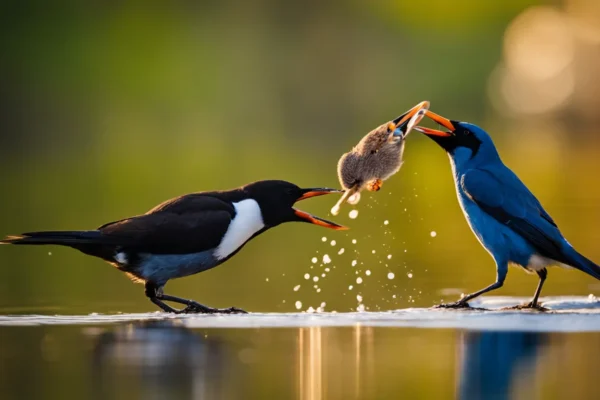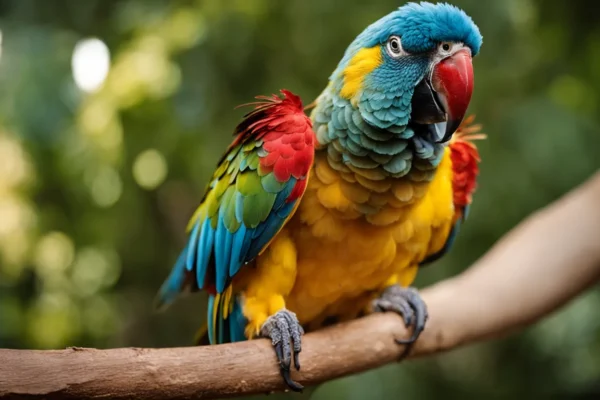If you’ve watched birds, you’ve undoubtedly noticed that they seem to go in the autumn and then return in the spring. You may be wondering whether they are indeed flying across seas to get to where they are migrating. It’s a very amazing accomplishment for something so little.
This is a simple response in case you’re pressed for time: Yes, in order to complete their annual migrations, several bird species are able to fly across continents for astonishingly lengthy periods of time. But not all birds migrate, and each species has a different migratory range. The science of bird transoceanic migration and a few record-breaking migrations will be discussed in this article.
Adjustments To The Body For Extended Flights
Regarding the amazing achievement of flying across seas, birds have developed a number of physical modifications that allow them to make these protracted and taxing flights. Because of these modifications, birds are able to fly for longer stretches of time and over greater distances without becoming fatigued or running out of energy.
Let’s examine a few of these incredible modifications:
Effective metabolisms
Compared to most other animals, birds can collect and use the energy from their food more efficiently because of their very efficient metabolisms. Their digestive tracts are designed to break down food fast and absorb as much energy as they can.
Because of this, birds can quickly transform their food into energy, giving them the fuel they need for their lengthy flights over seas.
Fat reserves
The capacity of birds to retain a lot of fat is one of the main characteristics that allows them to make lengthy flights. Birds eat enormous amounts of food in the days leading up to their migration, which they store as fat.
During their trips, these fat reserves provide them with energy, enabling them to survive in times when food is in short supply. It’s amazing how birds can gain fat reserves before to migration, allowing them to quadruple their body weight.
Wind-efficient forms
Birds’ streamlined body and carefully designed wings allow them to fly over extended distances. Because of the length and narrowness of their wings, they can cut through the air with little difficulty. Moreover, birds often fly in big flocks or in a V-formation to take advantage of the wind currents that the birds in front of them produce.
Because the birds in this configuration may take use of the uplift produced by the birds in front of them, less energy is needed to fly.
Ability to Navigate
Birds can travel great distances across seas on their migratory travels because of their exceptional navigational skills. Although scientists still don’t completely understand these skills, a number of ideas have been put out to explain how birds are able to travel across great distances.
Sun signals
According to one idea, birds utilize the sun’s position to help them navigate. Birds can identify their direction of travel by tracking the sun’s location and angle throughout the day. When the sun is visible throughout the day, this skill is quite helpful.
But birds can also find their way in gloomy or overcast weather, suggesting that they may use other signals as well.
Magnetic domains
According to a different notion, birds can detect and make use of the Earth’s magnetic fields for navigation. It’s possible that birds may sense changes in direction and strength of magnetic fields because of unique cells in their eyes that are magnetic field sensitive.
When there are few visual signals, such as at night or in hazy weather, this skill is very useful. This notion has been strengthened by the discovery of magnetic particle evidence in migrating birds’ beaks.
Maps based on scent
According to some scientists, birds that migrate may orient themselves by using their sense of smell. It’s been suggested that birds may map out various odors in their minds and utilize them to navigate. For instance, during their migration, birds may link certain odors to particular food sources or locations.
Although research on this idea is ongoing, it provides a fascinating explanation for how birds are able to travel great distances.
Even while these ideas provide light on how well birds navigate, it’s crucial to remember that migration is a complicated action that is impacted by a number of variables. During their amazing voyages across seas, birds most likely employ a mix of sensory information, magnetic fields, and smell-based maps in addition to solar signals.
Techniques for Cross-Border Migration
Regarding transoceanic migration, birds have evolved some amazing adaptations to deal with the enormous difficulties of flying over large quantities of water. Let’s examine three amazing strategies that allow these amazing migrations by bird species.
Island hopping
Island hopping is one method used by birds to guide their transoceanic migration. Numerous islands are located along important migratory paths, serving as vital rest and fuel stops for birds before they continue on their trip.
By serving as stepping stones, these islands enable birds to break up their lengthy trips and stop along the route to obtain food and shelter. For many migratory bird species crossing the Pacific Ocean, the Hawaiian Islands are crucial stopping locations.
Taking advantage of the weather
Birds also make use of weather patterns as a tactic. When flying great distances, birds’ exceptional sensitivity of wind pattern variations may be used to their advantage. Birds may save energy and go further more quickly by riding on favorable tailwinds and avoiding negative headwinds.
Birds may take advantage of atmospheric conditions and improve their chances of successfully traversing seas by using this weather-dependent migratory method.
Swarming to maximize effectiveness
Flocking is a third tactic used to facilitate transoceanic migration. During migration, birds often fly in big flocks, which provides a number of benefits. Initially, having a flock while flying lowers the chance of predation and offers protection in numbers.
Second, flocking distributes the physical strain of navigation and lessens tiredness by allowing birds to alternately lead the way. Finally, by using the aerodynamic lift produced by the bird ahead of them, birds flying in a V-formation may save energy for the whole flock.
Species like geese and ducks are known to exhibit this effective flocking behavior when they migrate.
These tactics—as well as several not included here—showcase the remarkable versatility and tenacity of birds throughout their transatlantic trip. It is extremely amazing and a monument to the marvels of nature that birds are able to navigate and overcome the difficulties of traversing large seas.
The Study of Bird Migration Ranges Science
Scientists and bird lovers have been captivated by the amazing phenomena of avian migration for ages. The remarkable capacity of birds to fly great distances over continents, mountains, and seas to find better nesting sites, food supplies, or temperate temperatures is astounding.
A number of variables, such as species, individual capacities, and environmental circumstances, affect the range of bird migration.
Normal migration paths
During their yearly trips, migrating birds often traverse amazing distances. The Arctic Tern, for instance, is the bird with the longest migratory path; it travels an incredible 44,000 miles (70,900 kilometers) round trip from the Arctic to the Antarctic and back.
Similarly, one of the longest nonstop flights ever documented in the history of birds is the Bar-tailed Godwit, which is known to fly over 7,000 miles (11,000 kilometers) nonstop from Alaska to New Zealand.
These incredible ranges demonstrate the migrating birds’ exceptional stamina and navigational abilities.
Migrations of records
Although the majority of migrating birds travel well-known paths, several extraordinary instances of record-breaking migrations have shocked biologists. Consider the amazing voyage of a shorebird with a tagging, a Whimbrel, which traveled 4,200 miles (6,760 kilometers) continuously over the course of nine days across the Atlantic Ocean from Canada to the tip of South America.
This amazing accomplishment demonstrates the extraordinary endurance and tenacity of certain bird species.
The Blackpoll Warbler is another noteworthy example; weighing less than an ounce, it can travel almost 1,500 miles (2,400 kilometers) continuously across the Atlantic Ocean from eastern North America to the Caribbean.
These remarkable long-distance migrations show how adaptive and resilient birds can be under difficult situations.
Factors influencing the range
Avian migration is influenced by a number of variables. The availability of appropriate stopover locations, where birds may relax, recharge, and restock their energy stores throughout their lengthy flights, is one important element.
The range of migration is also significantly influenced by the availability of sufficient food sources and appropriate weather.
Furthermore, a bird’s ability to fly a great distance depends heavily on its physical attributes and physiological modifications. Larger wingspans allow birds—like albatrosses—to glide more effectively, allowing them to travel great distances.
However, because of their tiny bodies and high metabolic rates, smaller birds, like hummingbirds, may only be able to migrate within a restricted area.
It is essential to remember that bird migratory patterns and ranges are also being impacted by habitat loss and climate change. Birds may have to rearrange their travel paths or have major difficulties finishing their travels when ecosystems shift and important stopover locations vanish.
To comprehend these changes and create conservation and preservation plans, scientists are still researching and tracking bird migration.
Dangers to Migratory Birds
A multitude of difficulties arise for migratory birds during their protracted and difficult oceanic migrations. These difficulties may have a major effect on both their population size and rate of survival. To ensure the survival of these amazing bird explorers and support conservation efforts, it is important to comprehend these concerns.
Loss of habitat
The lack of habitat is one of the main challenges to migrating birds. They may not be able to effectively finish their migratory excursions if their breeding, stopping, and wintering sites are destroyed or degraded.
One of the main reasons migrating birds lose their habitat is due to deforestation; other factors include urbanization and agricultural growth.
For instance, shorebirds’ ability to locate appropriate feeding and resting locations throughout their lengthy migrations may be significantly impacted by the degradation of mangrove forests in coastal regions. The migratory birds may find it difficult to locate new homes when these vital areas vanish, which might result in lower survival rates and population decreases.
Severe weather
Storms, hurricanes, and droughts are examples of extreme weather events that can seriously endanger migrating birds. These events can disrupt their migratory patterns, force them to change their flight routes, or even cause fatalities.
Birds that rely on specific weather conditions, such as favorable winds for long-distance flights, may face additional challenges when confronted with unpredictable weather patterns.
Furthermore, climate change is altering the timing and intensity of weather events, making it even more challenging for migratory birds to navigate and find suitable habitats along their journey. The increasing frequency and intensity of extreme weather events can have long-term impacts on bird populations and their ability to complete their migrations.
Human impact
Human activities have a profound impact on migratory birds. Pollution, including the release of harmful chemicals and the accumulation of plastic waste, can contaminate their habitats and food sources. This can lead to health issues and reduced reproductive success among migratory bird populations.
Another significant threat is the presence of man-made structures, such as buildings, power lines, and communication towers. These structures can pose collision risks for migratory birds, resulting in injury or death.
Additionally, light pollution from cities can disorient birds and disrupt their navigational abilities, leading to increased vulnerability during their journeys.
Conservation efforts aimed at mitigating these threats are crucial for the preservation of migratory bird populations. Protecting and restoring habitats, implementing measures to reduce pollution and light pollution, and raising awareness about the importance of migratory birds are all essential steps in ensuring their survival for future generations.
Final Thoughts
From arctic terns to bar-tailed godwits, birds prove themselves champion migrants each year by flying astonishing distances over oceans and continents. Gaining insight into the science, navigation, and threats facing migratory birds allows us to better understand and protect these epic travelers.
References:






